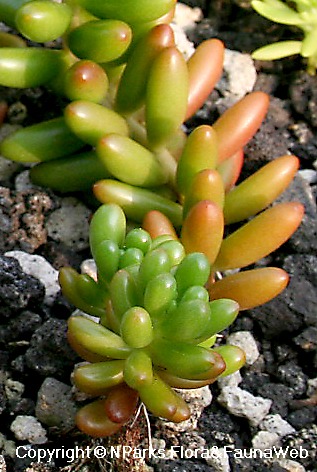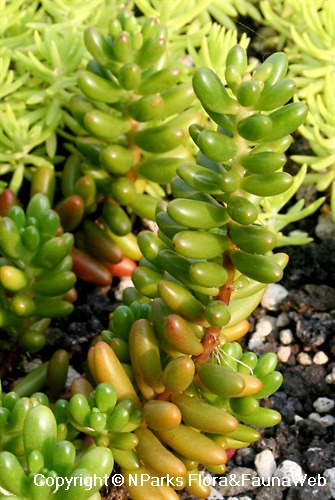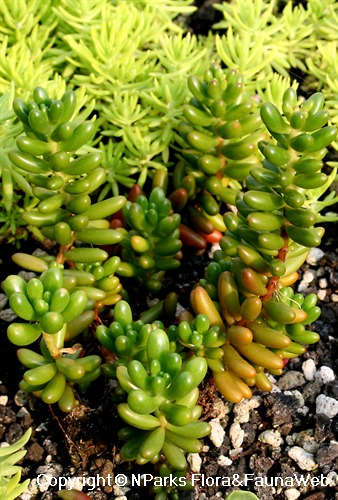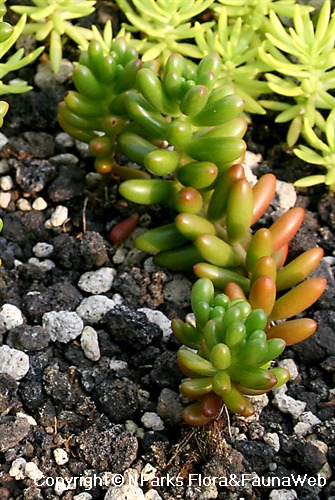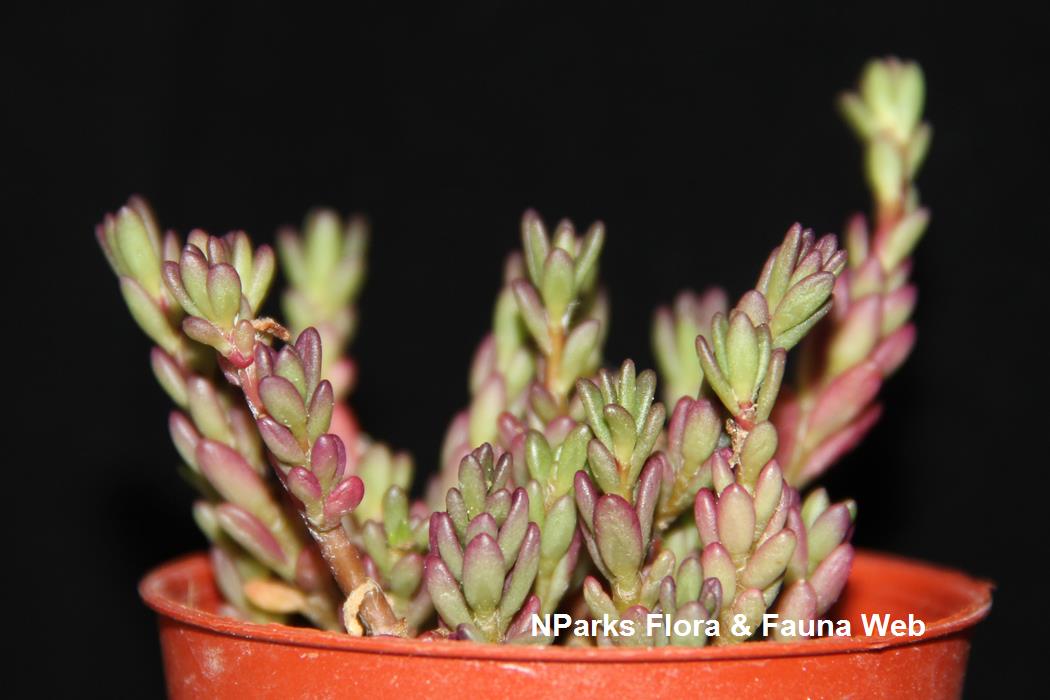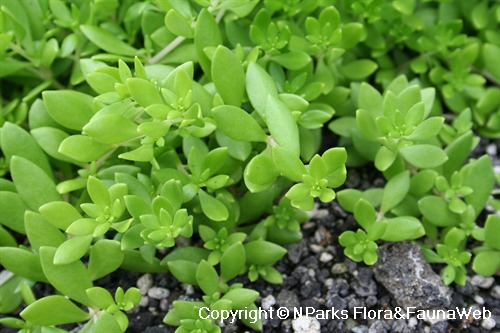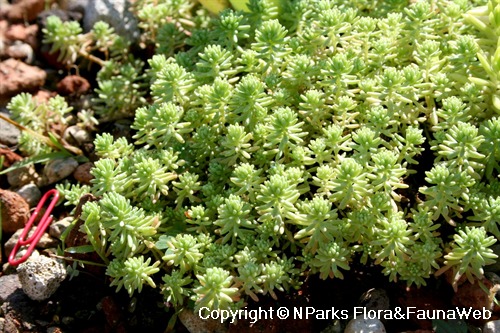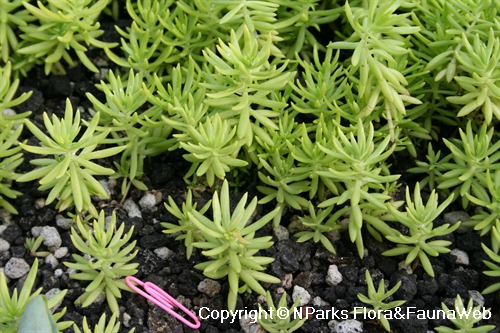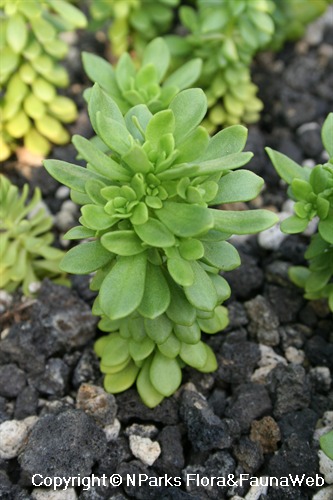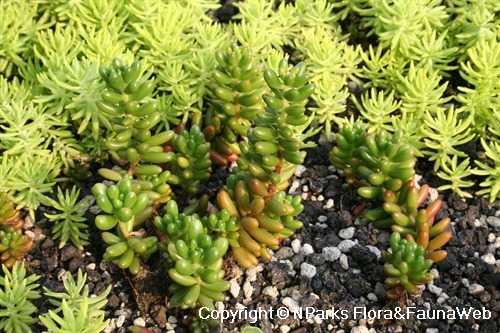
Back
Sedum × rubrotinctum R.T.Clausen
| Family Name: | Crassulaceae |
| Common Name: | Jellybean Sedum, Christmas Cheer, Pork & Beans, Banana Cactus |
Name
Classifications and Characteristics
| Plant Division | Angiosperms (Flowering Seed Plants) (Dicotyledon) |
|---|---|
| Plant Growth Form | Herbaceous Plant, Creeper |
| Lifespan (in Singapore) | Perennial |
| Mode of Nutrition | Autotrophic |
| Plant Shape | Dwarf |
| Maximum Height | 0.2 m |
Biogeography
| Native Distribution | Mexico (horticultural hybrid) |
|---|---|
| Preferred Climate Zone | Tropical |
Description and Ethnobotany
| Growth Form | Herbaceous succulent sub-shrub, 15 - 20cm in height. |
|---|---|
| Foliage | Fleshy oval leaves, glossy green-red, arranged spirally around fleshy stems. |
| Flowers | Yellow, borne in inflorescences, seldom produced and not observed in Singapore. |
| Similar | Of horticultural hybrid origin and found only in cultivation, thought to be Sedum stahlii × Sedum pachyphyllum. Previously confused with Sedum guatemalense, an epiphytic species. Chimeric cultivar 'Aurora' has chlorophyll-deficient leaf epidermis and completely pearl-pink colouration. |
| Cultivation | Provide full sun for more intense cherry-red colouration, leaves tend to turn glaucous green and plant becomes leggy when not exposed to sufficient light. Use well-drained media and allow to dry between each watering. Prefers neutral to slightly alkaline media, acidic media can lengthen internodes and make plant leggy. Thrives on neglect. Propagate by leaf cuttings or stem cuttings -- allow cut end to callous before planting in moist porous media. |
| Etymology | Genus epithet 'Sedum' derived from Latin verb for 'sit', a reference to how some species in this genus attach themselves to rocks and walls. Species epithet 'rubrotinctum' means 'red-dyed', describing how the leaves turn red under full sun. |
Landscaping Features
| Desirable Plant Features | Ornamental Flowers, Ornamental Foliage |
|---|---|
| Landscape Uses | Container Planting, Suitable for Rooftops |
| Thematic Landscaping | Rockery / Desert Garden |
| Plant & Rootzone Preference or Tolerance Remarks | pH 6.6 - 7.8 |
Plant Care and Propagation
| Light Preference | Full Sun |
|---|---|
| Water Preference | Little Water |
| Plant Growth Rate | Moderate |
| Rootzone Tolerance | Drought Tolerant, Shallow Media, Well-Drained Soils, Poor Infertile Soils |
| Maintenance Requirements | Moderate |
| Propagation Method | Stem Cutting, Leaf Cutting |
| Maintenance Requirements Remarks | Leaves become green and internodes lengthen if plant is exposed to insufficient light. Acidic media also lengthens internodes. |
| Planting Distance | 0 |
Foliar
| Foliage Retention | Evergreen |
|---|---|
| Mature Foliage Colour(s) | Green, Red |
| Mature Foliage Texture(s) | Smooth, Glossy / Shiny, Thick |
| Foliar Type | Simple / Unifoliate |
| Foliar Arrangement Along Stem | Whorled, Spiral |
| Foliar Shape(s) | Non-Palm Foliage (Oval) |
| Foliar Margin | Entire |
| Foliar Apex - Tip | Acute |
| Typical Foliar Area | Microphyll ( 2.25cm2 - 20.25 cm2 ) |
| Leaf Area Index (LAI) for Green Plot Ratio | 4.5 (Shrub & Groundcover - Dicot) |
Non - Foliar and Storage
| Stem Type & Modification | Herbaceous |
|---|---|
| Root Type | Underground (Fibrous Root) |
| Specialised Storage Organ(s) | Aboveground |
Floral (Angiosperm)
| Flower & Plant Sexuality | Bisexual Flowers |
| Flower Colour(s) | Yellow / Golden |
|---|---|
| Flower Symmetry | Radial |
| Flowering Period | Rarely |
| Flowering Habit | Polycarpic |
Image Repository
Others
| Master ID | 1154 |
|---|---|
| Species ID | 2447 |
| Flora Disclaimer | The information in this website has been compiled from reliable sources, such as reference works on medicinal plants. It is not a substitute for medical advice or treatment and NParks does not purport to provide any medical advice. Readers should always consult his/her physician before using or consuming a plant for medicinal purposes. |

